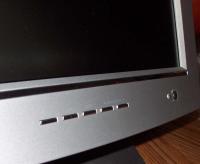Daewoo L700C & L520B: Value Oriented 17'' and 15'' LCD's
by Kristopher Kubicki on November 28, 2002 4:01 AM EST- Posted in
- Displays
On Screen Display
While not quite the caliber of the Samsung OSD’s, the Daewoo on screen displays performed very well. The menus were clean and all the buttons were controls were easily identifiable.
L700C
On the L700C,
the OSD was driven by 7 slim buttons that closely resembled the buttons on
the Samsung 191T we reviewed. From left to right they were: Auto, Exit, Menu,
Power, Select and two buttons for Brightness. Menu and exit were fairly intuitive,
and the menu options were easily selected by using the Brightness buttons.
Odd to see was the “clock” setting, which actually was more of a timing control on the display frequencies in the monitor. Since most LCD monitors have been shipping with "Auto" buttons, we have found the importance of most menu options steadily decreasing. However, for the enthusiast, it is good to know they are there.
L520B
The L520B operated
much the same way as the L700C. The only difference being the Menu and Select
button were combined into one button, and the power button was moved all the
way to the right hand side of the bezel. The menu had a slightly different
look, but the options and functions were all identical.
Again we noticed the presence of the “Auto” control button. Unlike a lot of other “Auto” synchronizations we have used, the Daewoo “Auto” seems to hit the head on the nail every time. We will note that the Auto synchronization is a lot slower than any calibration we have seen in any of the monitors we have reviewed, but then again we only have to press the button once with either of these monitors.












0 Comments
View All Comments